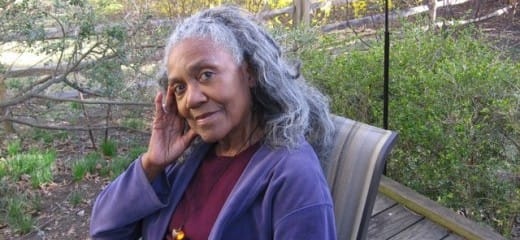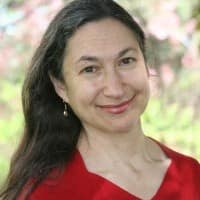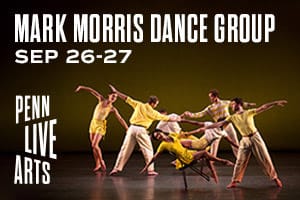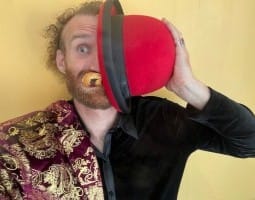Brenda Dixon Gottschild, performance researcher and writer, emerita professor at Temple University, and resident of Philadelphia for over thirty years, began as a dancer with Donya Feuer, Paul Sanasardo, and the Mary Anthony Dance Theater. In the late 1960s, she taught and performed in Helsinki and London. Returning to the U.S., she joined Joseph Chaikin’s Open Theater. Her master’s degree, on playwright/director Bertolt Brecht, and doctoral degree, on vaudeville dancer Margot Webb, are from New York University, where she studied with Michael Kirby and Richard Schechner. She served as teacher and administrator at the College of New Rochelle before joining Temple University’s Dance Department, from which she retired in 1999. Brooks interviewed Dixon Gottschild in May 2016.
LMB: You are a dancer, scholar, teacher, activist, and public figure. How do you see these roles having an impact on others?
BDG: We teach because we feel that we can educare [Latin,“to train, mold“]—pull that light out of others by shining our own light. That is the circular nature of what we do as human beings in whatever métier, but certainly as teachers or, in my case, as a teacher/activist. It’s a learning/giving experience that comes out in ripples, concentric circles. Of course, my four independent books[1] have been a major way my work has influenced the world at large. Wherever I go, students say, “We never thought we would meet you,” or, “I loved this book,” “This is my Bible, I carry it with me.”
LMB: How has the dance field changed over the course of your involvement with it?
BDG: I say this with no vanity: I feel that my research has changed the field of dance academic study quite a bit. When I started out, to even say “Africanist aesthetic” in the same breath as “Balanchine” was taboo. People are now reading those chapters from my books; that is a sea change in how dance departments are visioning dance research.
Initially, I was not looked upon as an accomplished scholar by anybody in the Society of Dance History Scholars. It was quite separate from the Congress on Research in Dance. My getting a foot in the door was a huge accomplishment, and Temple gave me that opportunity. People were so supportive: Hellmut [Gottschild], Edrie [Ferdun], Sarah [Hilsendager]. Nobody had done this kind of research—the black aesthetic in so-called white concert dance. It had been either this or that; and of course it’s never “either–or,” it’s always “and.” Temple was really behind me. In 1983 there was this huge conference called Black Dance America; people like Sally Banes talked about black/Latino hip-hoppers; Sally Sommer about black tap dancers. Nobody was talking about intersections. Katrina Hazzard-Gordon was the only other African American researcher on the scene. Her book Jookin’ was about black dance in the black dance community; my work made the jump, applying the black aesthetic to white concert dance. I don’t think I originated particular kinds of research; I’m the patchwork quilt-maker of cultural aesthetic research, putting the pieces together, and that was a piece that hadn’t been put in, which I deal with at length in Digging the Africanist Presence in American Performance.
LMB: What changes do you see in Philadelphia dance over time? Do those changes parallel changes in the larger dance scene?
BDG: Since 1984, Philadelphia has been my home, the seat of this expansion of ways dance research is perceived now. The changes in Philly are changes I see not only nationally, but globally. So much has happened in the new millennium, we’re connected so integrally. The main thing I’ve seen is the hip hop explosion. I call hip hop the newest child of the Africanist aesthetic, mothered by jazz, blues, funk, gospel—all of it. By the end of the ’70s, contact [improvisation] was already giving pause to modern dance, and in this global era, I think the hip hop aesthetic, once thought to belong to a certain community, has blossomed in a major way. That’s made a basic change in the ways dances are constructed, which is definitely not according to a “modern dance model”—Graham, Wigman, Cunningham, or whoever. There’s a basic conceptual and even kinesthetic difference to how dance is perceived now, and Philadelphia is part of that movement. Maybe it also has to do with the body knowledge coming from things like yoga and Pilates, which has prompted people to put things together differently—embodying and kinesthetically learning things, not only intellectually or philosophically. We have thinking bodies and dancing heads!
LMB: Are there changes or developments you long to see? If you could shoot the arrow, where would it land?
BDG: I would burst the arrow into the tiniest, indecipherable shards possible at racism—the most glaring, tragic, intransigent issue in every sector of the American landscape. The dance world is a microcosm of society as a whole. What I wish globally is that African diasporic aesthetic riches be no longer ripped off without credit (monetary) or acknowledgment (power), but be given what and when they are due. I recently did this workshop organized by Maria Bauman, who’s doing her master’s at Temple, coming out of Urban Bush Women and her own dance theater. She’s part of the People’s Institute for Survival and Beyond, and their business is undoing racism. Maria and Lela Aisha-Jones worked together the weekend of April 9th with forty dance practitioners in this workshop about undoing racism. It’s very powerful, very moving.
I want to give an example of this dream, that credit and acknowledgment be given where they’re due. There is an artist who is part of a faculty richly endowed with African American hip hop and vernacular dance specialists, and therefore, he’s able to frame his explorations with some depth and cultural grounding, but I am not sure he is: I’m speaking of Bill Forsythe. There’s an Instagram circulating of him teaching hip hop movement to his company for a new piece he’s creating. Who is he going to credit? Whose concerts has he attended? What guest teachers has he invited to his classes? What YouTubes has he watched? I’ve always respected and admired Forsythe’s work. Francesca Harper is one of the people I interviewed for The Black Dancing Body; she speaks at length about the ethnically integrated company—integrated in every sense—that he had with the Frankfurt Ballet, and she, a very tall woman, was in it—all kinds of people were en pointe doing ballet. I posed a question to Forsythe last year at an open forum at the Arts Bank, asking if he could help Angel Corella to follow his model and bring in more dancers of color, of African diasporan background, to Pennsylvania Ballet.
I admire Forsythe, but I know he is on this faculty now with these incredible hip hop artists. Where’s the credit going to be given? This goes back to African art purloined in that Berlin conference in 1884, when Africa was given away—Belgium has the Congo, France has this, etc. And all these beautiful art pieces were taken to museums uncredited—they’re by “anonymous” artists. No they weren’t! They were people! Then, Picasso, Braque, and Matisse—all the people were using that, and it’s as though, “it’s just there for us to use, to ‘refine’ and ‘finesse.’” No! And, no, not in the new millennium, Bill Forsythe!
LMB: What projects are absorbing you now? What lies ahead?
BDG: In 2012 I founded the Coalition of Diasporan Scholars Moving (CDSM) for academics. There is a difference between recruitment and retention. Perhaps you think it’s progress if an African American is hired, but look at statistics for the number of tenured professors of African descent in any field: it is saddeningly small. I started the CDSM because, as a senior scholar, I was getting emails from people saying, “I found your name,” or “I admired your book,” and “I’m in this department and I don’t know why, but they are not putting me up for tenure.” I felt I couldn’t deal with this alone, so I contacted some colleagues—Tommy DeFrantz, Yvonne Daniel, other senior African American scholars—and said, what do I do with this? I took one or two cases to them, and then met this group of wonderful young people here in Philly—Jaamil Kosoko, Lela Aisha-Jones, Peaches Jones, Saroya Corbett. We are now under the umbrella of the International Association for Blacks in Dance (IABD). And every year at IABD I have an open conversation on issues that have come up. We as African diasporic people need that so much, this place where we come together and talk, as we also need IABD, which is open to everybody. It’s wonderful when you go—like when I go to Dance History Scholars and I’m in the minority; lots of white people go to IABD and they’re in the minority. Those are experiences that we all need to understand—what it means in a country like the USA to not always be in the majority.
I’ve been invited to hold pre-performance conversations with Liz Santoro, Gus Solomons and Valda Setterfield, and Jaamil Kosoko and [Honji] Wang/[Sébastien] Ramirez at Tanz im August this summer in Berlin. For Central Park SummerStage, June 29th, I’ve put together a panel on black ballerinas, to precede the screening of A Ballerina’s Tale. Danielle Gee had been a Philadanco dancer years ago and is the dance curator for Central Park SummerStage, so she asked me to do that. On the panel are Francesca Harper, Joan Myers Brown, Christina Johnson, and Theresa Howard.
I’ve been invited many times to UC Boulder and was the Cox Family Scholar for Theater/Dance Department in 2011. Gesel Mason is on faculty and is doing a wonderful project called No Boundaries, meaning African American choreographers’ works are beyond boundaries, and she is becoming the embodied archive for dances that people are putting on her. She has dances by David Rousseve, Donny McKayle—the first dance that Donny ever did, he put on her—Jawole [Willa Jo Zollar], Reggie Wilson, others. She invited Tommy DeFrantz, Jaamil, and me for a forum this past September, and asked us each to do a presentation on who we are now. I showed a video, made by WHYY when I did my last book, and read some poems by Claudia Rankine in that award-winning collection, Citizen. Jaamil said, “I love the way you read those poems. Could I get you to do that at Movement Research [in November 2015]?” With her poems, some bits from The Black Dancing Body, and some from Chimamanda Adichie’s Americanah, I did a very Open Theater-style performance, where I jam on words, do some movement, come in as a character. I made a performance out of it; I was back in my element. I had the opportunity to do it again at Sacramento State recently, and I’m ready to pitch it!
It’s so important for me to open the windows and doors, the hearts and minds and spirits, not only to people of African descent, but also to their ideas and their health. It’s what I hope and believe I’m doing with my work. That’s the point of it all.
[1] Digging the Africanist Presence in American Performance: Dance and Other Contexts (1998), Waltzing in the Dark: African-American Vaudeville and Race Politics in the Swing Era (2002), The Black Dancing Body: A Geography from Coon to Cool (2005), and Joan Myers Brown and the Audacious Hope of the Black Ballerina: A Biohistory of American Performance (2011).






